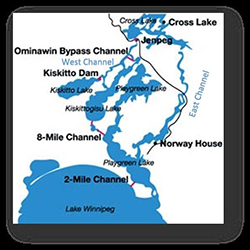Lake Winnipeg Regulation

The Lake Winnipeg Regulation (LWR) is primarily a flow regulation project. The project area is between the north end of Lake Winnipeg and the Jenpeg Generating Station and Control Structure (Jenpeg site).
The Jenpeg site is about 500 kilometers north of Winnipeg. It is approximately a seven-hour drive from the City of Winnipeg, accessible by PR 373.
The project increases Lake Winnipeg’s outflow capacity by about 50% compared to pre-project conditions.
It controls:
-
Lake Winnipeg outflow to enhance power generation along the Nelson River; and
-
Extreme lake levels (i.e., highs and lows) under both flooding and drought conditions.
Please follow the inset figure to learn more about the project. Lake Winnipeg has a natural outlet, which connects it to Playgreen Lake. The LWR project created a second outlet for Lake Winnipeg using the 2-Mile Channel.
It has a network of other channels (e.g. the 8-Mile and Ominawin Bypass Channels) and the Jenpeg site. Kiskitto dam at the outlet of Kiskitto Lake prevents water from backing up into that lake. Lake Winnipeg’s outflow is regulated through the west channel of the Nelson River. The east channel is not regulated.
The Manitoba government issued an Interim Water Power Act Licence in 1970 and a Supplementary Interim Water Power Act Licence in 1972 to allow the construction of the project. Construction began in 1970 and the LWR was in operation in 1976. The Final Water Power Act Licence for the LWR was issued on May 12, 2021.The licence will expire on August 1, 2026. It includes five new licensing terms and four non-licensing conditions. These inter-connected conditions address environmental concerns heard during the consultation process and further recommendations in the Regional Cumulative Effects Assessment Report.
These conditions require that Manitoba Hydro expand the existing Coordinated Aquatic Monitoring Program (CAMP) with input from Indigenous communities and using Indigenous Traditional Knowledge, address shoreline erosion, participate in future planning and studies (e.g., habitat studies, and flow regime scenarios) with input from Indigenous communities and using Indigenous Traditional Knowledge, and participate in provincial large area planning initiatives led by the province.
The Final Water Power Act licence allows Manitoba Hydro to regulate Lake Winnipeg’s (lake) outflow for electricity generation on the Nelson River by using the Jenpeg site. When the lake level is between 216.7 m (711 ft) and 217.9 m (715 ft) above sea level, Manitoba Hydro may set lake outflows as required for power production purposes along the Nelson River. When the lake level is above 217.9 m (715 ft), Manitoba Hydro must allow the maximum discharge possible under the circumstances until the lake level returns to 217.9 m (715 ft). During low flow periods when the lake level is below 216.7 m (711 ft), Manitoba Hydro must operate the Jenpeg site as ordered by the Minister responsible for the administration of The Water Power Act.
Manitoba ensures that Manitoba Hydro follows the terms and conditions of their Final Water Power Act licence through review of compliance reports (e.g., annual Indigenous engagement report, licence implementation guide, 90-day water level and flow forecast, monthly and annual water level and flow reports, etc.), compliance plans, regular meetings, and site visits.
Water Power Act Licences
Licence Related Documentation
- Renewal Licence Request (July 26, 2022)
- Lake Winnipeg Regulation & Jenpeg Generating Station Licence Implementation Guide (May 2022) - This guide enables Manitoba and Manitoba Hydro to document a common understanding of compliance with the final licence. It provides the methodology to be used to determine water levels and flows, definition of licence compliance terms, and protocols for reporting.
- Final Licence Support Report (March 9, 2015)
- Severance Line Drawing (March 6, 2015)
- Final Licence Request (December 22, 2010)
- Lake Winnipeg Regulation Report in Support of a Request for a Final Licence
- Lake Winnipeg Regulation Severance Line Drawings (Coming Soon)
Reports
- Annual Reports
- Indigenous Engagement, Public Safety, Shoreline Stabilization, and Debris Management Annual Reports
- Regional Cumulative Effects Assessment
- Review of Lake Winnipeg Water Level Reporting Procedures" - W.F. Baird & Associates Coastal Engineers Ltd., Ottawa, Ontario, January 2000.
- Report on Lake Winnipeg Water Levels, December 1982
- Summary Report - Lake Winnipeg, Churchill and Nelson Rivers Study Board Canada, Manitoba / April, 1975


